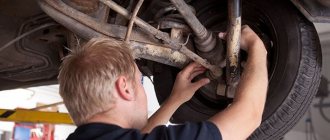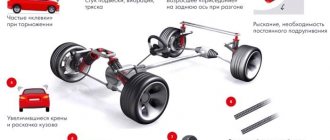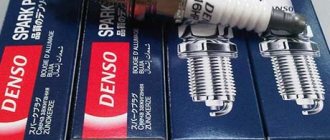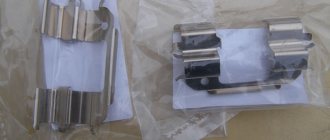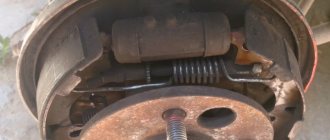When to change brake pads on Camry 50
Worn and new
It’s easy to understand that it’s time to change the brake pads. It is enough to pay attention to the behavior of the car while driving. Signs of pad wear on Toyota Camry 50/55:
- Dips in the brake pedal. When braking, the pedal may sink and braking efficiency will decrease. Such a picture may also indicate problems in other elements of the system, for example, in the cylinders or in the fluid reservoir.
- Feeling of strong vibration when pressing the brake pedal. Uneven wear of the linings leads to vibration, which can spread not only to the pedal, but also to the body of the Toyota Camry.
- Creaks and whistles when braking. Extraneous sounds indicate a malfunction in the brake system of the Toyota Camry, but may also be a signal that consumables need to be replaced. We are talking about the so-called “creak”, i.e. area of the lining, which warns the driver when the pad wears out.
- To be completely confident in the serviceability of the brake mechanism parts, a complete inspection of the working units is required. This is explained by the fact that sensors sometimes fail and mislead the driver.
- When the friction linings of Toyota Camry 50/55 wear out, the fluid level in the expansion tank decreases. A decrease can also be associated with a leak, so if a drop in level is detected, an inspection is required.
Original pads and expensive analogues
They have the highest quality. They do not creak or knock during operation. The cost is high, like all original foreign-made spare parts. Made from wear-resistant material, they last as long as they should. The price for “native” Camry 40 pads is significantly lower than for other Japanese foreign cars. However, those who do not want to spend an exorbitant amount on brake pads from the manufacturer can buy cheaper brands, but also with high quality. The manufacturer of Japanese auto parts is usually Japan. However, sometimes parts are manufactured in other countries, which should be marked accordingly on the packaging. The most popular models are:
- Akebono is a fairly expensive Japanese original. The quality is time-tested and always at its best.
- Kashiyama - pads are sold from Indonesia. The quality is average: they do not generate dust, do not creak, and can withstand a mileage of 30-40 thousand km. Sold in blue and white packaging. The manufacturer is not indicated on the box. Previously, the Kashiyama brand was also produced in Japan. Japanese pads from this company were sold in a box marked “made in Japan”; the price of such mechanisms was higher and lasted longer. However, many car enthusiasts noted that the pads made a squeaking sound when driving.
- NBK is a Japanese production of average quality. They do not sell on the Russian market under their own brand.
The specified range of models has acceptable quality and meets the basic requirements for brake parts. The price is a bit expensive, but they last quite a long time. You can additionally see what the original models of pads on a Camry look like on online store websites.
Mid-price models and cheap analogues
Mid-price items for lovers of an equal price-quality ratio. Such brands are quite reliable and also meet all the parameters. However, some models may be inferior to expensive ones in terms of service life and have certain disadvantages (dust, knock, creak when moving. In order to choose a suitable model, you will have to experiment. These are mainly brands of European manufacturers:
- Textar – production technology developed in Germany, sold in the UK. They have good reviews from car enthusiasts and sellers. The product packaging is reliably protected by the TDM Triction hologram. The set is complete, except for the anti-squeak plates.
- TRW (Lucas) is a fairly popular and expensive brand for its category. The quality is average and doesn't deserve the price. Based on reviews from car service centers and buyers, you can find equally decent brake parts at a lower price.
- Remsa is a Spanish brand of good quality: there are no complaints about creaking or fragility. They have a glued heat-protective plate. Many car owners prefer them.
- Bosch - most of the parts from this company are removed from the Chinese assembly line. The price is low, the quality is appropriate.
- Fenox is the cheapest brand. The company is Belarusian, however, judging by the price, the bulk of the parts are produced in China. The quality is average, no major complaints.
As you can see, the choice is varied. There are many options to choose a model based on your own needs and wallet.
Accurately determine lining wear
The degree of wear of the Camry linings is determined visually. Pay attention to the outer and inner pads and the brake disc itself. Deep grooves and scratches indicate the need to install new consumables. Measuring the thickness of the pads and disc using a caliper or ruler allows you to accurately determine whether replacement is required.
To check the condition of the working components of the Camry 50 brake system, you will need to dismantle the front wheel. It is necessary to evaluate not only the linings and disc, but also the caliper guides and anthers.
When installing new parts, lubricant is used.
When checking, you can focus on the slot running along the friction lining. If the element is worn out so that the slot is not visible, a replacement is needed.
When measuring the thickness of the front pads, check the following data:
- nominal disc thickness – 27.5 mm, minimum – 25 mm;
- The nominal thickness of the linings is 8 mm, the minimum is 1 mm.
Types of brake pads for Toyota Camry V40
There are several types of brake systems on the Camry 40. They differ from each other in the following parameters:
- Price category;
- Manufacturer country;
- Qualitative indicators.
The car enthusiast himself makes his own conclusions about which models are worth paying attention to. Some people prefer to neglect quality for the sake of saving money, while others are adherents of original Japanese mechanisms. The price of pads is based on their quality indicators. According to the price parameter, all Camry 40 brake systems can be divided into 4 segments:
- original;
- expensive analogues;
- analogues of the middle price category;
- cheap non-original models.
It is most logical to purchase spare parts for foreign cars, especially brake pads, from well-known manufacturers. Below we will look at the main brands that the modern market offers.
Articles
The original front brake pads go under article number 0446533450 . Another original article number 04465-33471 .
Dimensions of the original spare part in mm – thickness 17.4, width 157), height 56.9. Analogs are supplied under catalog numbers:
- NIBK (PN1521);
- REMSA (1233.00);
- BREMBO (P 83 117);
- BOSCH (0 986 494 430);
- TRW (GDB3429);
- FERODO (FDB1991).
The original Camry 50 rear brake pads come under the article number 0446633200 . Original dimensions in mm – length 96.8, thickness 15.4, height 49.3.
Analogue consumables for Camry 50:
- NIBK (PN1522);
- ADVICS ('SN134)
- BREMBO (P 83 089);
- FENOX (BP43068);
- TRW (GDB3426);
- FERODO (FDB1892).
Catalog number TRW PFG110 is a good lubricant for guide supports.
Catalog number 477-695-0010 - original caliper guide plugs.
General technical specifications
Camry 40 pads consist of a housing, a friction lining, a brake disc and a special metal plate, which creates an unpleasant sound signal when worn heavily. Faulty brake pads significantly increase the stopping distance of a vehicle, which can cause a car accident.
Therefore, you need to approach the choice of brake systems with special attention. Before you start searching for a suitable model, you need to study the technical characteristics of the pads that are installed on your machine.
| Front brake pads | |
| Technical indicator | Options |
| Brake disc diameter | 296 mm. |
| Brake disc thickness | 25-28 mm. |
| Brake disc runout | 0.05 mm. |
| Friction lining thickness | 1-12 mm. |
| Rear brake pads | |
| Brake disc diameter | 280 mm. |
| Brake disc thickness | 8.5-10 mm. |
| Brake disc runout | 0.15 mm. |
| Friction lining thickness | 1-11 mm. |
| Drum parking brake | |
| Drum inner diameter | 170-171 mm. |
| Friction lining thickness | 2 mm. |
After a detailed study of the technical nuances, you can begin to select a brake mechanism.
Which pads are best to buy?
(Link to photo source)
Of the popular non-original consumables, drivers’ choice most often falls on NiBK products. The pads from this manufacturer provide smooth braking, the service life of consumables is long, and the elements do not creak.
Data taken from partreview.ru Click to enlarge
Replacing front pads Camry 50/55
To replace the front pads on a Toyota Camry 50, you will need keys (14 and 17), as well as pliers. First you need to check the brake fluid level. If it is close to the upper limit, it is necessary to pump out some of the liquid to prevent overflow when installing new parts.
(Link to photo source)
Elements of the braking system are replaced only in pairs, on both wheels of the same axle.
Procedure for updating Camry 50 front pads:
- The wheel on the side where the replacement will be carried out is dismantled.
- The fasteners of the guide pins are unscrewed.
(Link to photo source)
- The released caliper is suspended and fixed on the rack.
- The pressure springs are removed and both pads (inner and outer) are removed.
- The support plates are removed from the guides. The guides are lubricated, and the integrity of the protective covers is checked. They change if necessary.
- The lubricated support plates are returned to their place, new pads are installed. Further actions are carried out in the reverse order of dismantling.
- After installing the wheel back, you need to press the brake pedal several times to bring the pads to the disc.
Similar actions are performed on the other side of the Camry 50/55.
Replacing front brake pads Camry 40
Replacement of the front pads on a Toyota Camry car is carried out in case of excessive wear of the friction lining, its loose fit to the base, if traces of oil are detected and gross damage (grooves and chips).
Installation of new parts is carried out completely, i.e. Four pads need to be changed at once (in pairs for the right and left wheels). Before starting work, check the brake fluid level. If it is at the maximum level, you need to pump out part of it using a syringe. New consumables from Camry 40 after installation lead to an increase in level.
Necessary tools are keys (14 and 17), pliers. The order of work is as follows:
- Toyota Camry 40 is jacked up and the wheel is removed from one side.
- The fasteners of the caliper guide pins are unscrewed. The dismantled caliper is moved to the side and secured with a wire to the rack. The brake hose should not stretch or bend excessively.
Springs for spreading the pads
- The pressure springs are removed, and then the pads themselves (inner and outer). The support plates are removed.
- In case of damage, the protective covers of the fingers are replaced with new ones; if the movement of the calipers is difficult, the finger is lubricated, and the lubricant is also placed inside the protective cover.
- The support plates are returned to their place; they must first be coated with lubricant. New consumables are installed in the reverse order. You can prevent fasteners from turning by using an anaerobic thread locker.
(Link to photo source)
- After installation, depress the brake pedal several times and put the wheel in place. A similar procedure is carried out on the other side.
After changing the brake mechanisms, it is better not to brake sharply at high speed for the first 20-40 km. The elements need grinding in.
Replacing rear pads Camry 50/55
To replace the Camry 50/55 pads located at the rear, you will need the following tools:
- jack for raising a car;
- head or key (14th);
- device for pressing in the piston of the working brake cylinder.
Brake linings are changed only all at once (4 pieces) on one axis. Camry 50/55 rear pads are changed as follows:
- The wheel fasteners are loosened so that after jacking it is easier to twist the wheel.
- The Camry 50 is lifted with a jack and stops are placed to prevent it from rolling.
- Use a 14 mm wrench or socket to unscrew the caliper mounting bolts.
- The dismantled caliper is placed to the side; it can be fixed on the rack. The main thing is to prevent kinks and excessive tension in the hose.
- Next, consumables that have exhausted their resource are removed. First you need to pay attention and also remember the location of the lining wear sensor. The sensor is a bracket that begins to come into contact with the disk when the friction layer is extremely abraded. A corresponding sound will signal to the driver that the time has come to change consumables.
Wear sensors
- The guide boots are inspected for integrity. If damage is detected, the part is replaced.
- The mounting brackets of the pads are cleaned of dirt. A number of manufacturers supply a complete set of pads with brackets.
Remove and clean staples
- If the old wear sensors on the Camry 50 are working, you can leave them.
- To install the caliper in place, you will need to press the piston located inside the cylinder. You can simplify the task if you remove the cap on the expansion tank. But the liquid is hygroscopic, so do not leave the tank open for a long time.
open the barrel
Press in the piston
Screw the lid on as quickly as possible
The wear sensor should be at the bottom.
Installation of parts is carried out in the reverse order. During the final check of the condition of the working units, the brake pedal is depressed.
Replacing rear brake pads Camry 40
To replace the rear pads you will need a flat-head screwdriver and a pair of 14mm wrenches. Procedure:
- The car is lifted with a jack. The rear wheel is removed from one side.
- A screwdriver is inserted between the outer pad of the Camry 40 and the caliper, the caliper moves outward, thereby recessing the piston into the working cylinder.
(Link to photo source)
- The lower pin bolt is unscrewed with a key; from turning the pin, it must be held with a second key.
- The caliper is moved to the side and worn parts are removed.
(Link to photo source)
- If necessary, lubricant is used in the same way as when installing the front pads of the Toyota Camry 40. The plates are also lubricated.
- New consumables are installed in the reverse order. The brake pedal is pumped and the wheel returns to its place.
- Similar actions are carried out with the other wheel.
You need to update the Camry 40 brake system consumables in pairs so as not to reduce braking efficiency.
Useful tips
The pads on the Camry 50 must be replaced when worn. Parts need to be replaced only as a complete set, otherwise braking efficiency will be significantly reduced.
Before installing new consumables, it makes sense to pump out some of the liquid from the tank to prevent overflow. It is easy to press the piston into the cylinder using a screwdriver inserted between the piston and the inner lining.
After updating the pads on the Camry 50, you need to drive carefully so that the parts get used to each other. During the first 100 km, the brake efficiency may be reduced.



